

Finding an Authentic Goal for Your PBL Classroom. When we talk about project-based learning (PBL), we focus our curriculum on finding real-world ways for students to learn problem-solving and communication skills.

When doing this, authenticity is key. When you are first developing a PBL unit, you must begin the journey by establishing an authentic goal. By the end of the unit, you want students to have solved something. Along the way, they will have written, collaborated, created, pitched, discussed, and presented. It sounds overwhelming, especially if you haven't found that launching pad (authentic goal) in the first place.
I think this is the main reason why the e-NABLE Community Foundation seems to have taken the PBL world by storm. e-NABLE initially began in 2013 as a simple but powerful matching service between children who might benefit from receiving prosthetic hands and designers and makers who could construct those hands inexpensively and quickly. A New Infographic on Project-based Learning for Teachers. July 12, 2016 According to BIE, project based learning is “an instructional approach built upon authentic learning activities that engage student interest and motivation.
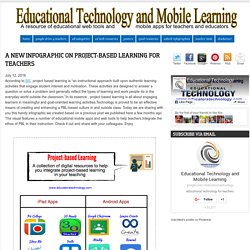
These activities are designed to answer a question or solve a problem and generally reflect the types of learning and work people do in the everyday world outside the classroom.”In its essence , project based learning is all about engaging learners in meaningful and goal-oriented learning activities.Technology is proved to be an effective means of creating and enhancing a PBL-based culture in and outside class. Today we are sharing with you this handy infographic we created based on a previous post we published here a few months ago. The visual features a number of educational mobile apps and web tools to help teachers integrate the ethos of PBL in their instruction. Check it out and share with your colleagues. Enjoy. Actes du colloque 2015. 6 Strategies for Differentiated Instruction in Project-Based Learning.
Project-based learning (PBL) naturally lends itself to differentiated instruction.

By design, it is student-centered, student-driven, and gives space for teachers to meet the needs of students in a variety of ways. PBL can allow for effective differentiation in assessment as well as daily management and instruction. PBL experts will tell you this, but I often hear teachers ask for real examples, specifics to help them contextualize what it "looks like" in the classroom.
We all need to try out specific ideas and strategies to get our brains working in a different context. Here are some specific differentiation strategies to use during a PBL project. 1. We all know that heterogeneous grouping works, but sometimes homogenous grouping can be an effective way to differentiate in a project. 2. Reflection is an essential component of PBL. École: leçon de notation.
La rumeur, pourtant prestement démentie, a enflammé la Toile et les ondes en quelques heures: l'Education nationale envisagerait de supprimer les notes de 0 à 20.
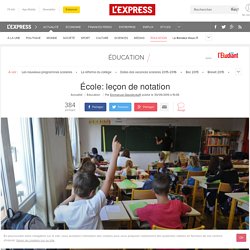
Ce tollé en dit long sur l'ignorance crasse des Diafoirus improvisés de la docimologie - l'étude des facteurs déterminant la notation aux examens et aux concours. Dès 1920, le psychologue américain Edward Thorndike parvient à isoler ce qu'il appelle "l'effet de halo". Entré dans le langage courant des élèves en des termes plus triviaux - "la note de gueule" -, il confirme ce que le bon sens suggère: plus un enseignant a une bonne image globale d'un élève, plus sa notation sera indulgente.
En 1965, Jean-Jacques Bonniol prouve qu'une copie moyenne sera sur-notée si elle est corrigée après une mauvaise copie et sous-notée si elle l'est après une excellente copie. Une école attentive à la réalité des apprentissages Une première piste invite à défendre la note en tant que partie d'un tout qui la dépasse: l'évaluation. Back to School with Trello. Project-Based Learning vs. Problem-Based Learning vs. X-BL. At the Buck Institute for Education (BIE), we've been keeping a list of the many types of "_____- based learning" we've run across over the years: Case-based learning Challenge-based learning Community-based learning Design-based learning Game-based learning Inquiry-based learning Land-based learning Passion-based learning Place-based learning Problem-based learning Proficiency-based learning Service-based learning Studio-based learning Team-based learning Work-based learning . . . and our new fave . . .
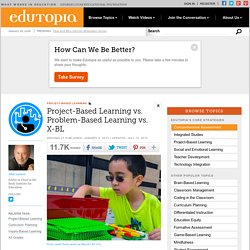
Zombie-based learning (look it up!) Let's Try to Sort This Out The term "project learning" derives from the work of John Dewey and dates back to William Kilpatrick, who first used the term in 1918. Designing and/or creating a tangible product, performance or event Solving a real-world problem (may be simulated or fully authentic) Investigating a topic or issue to develop an answer to an open-ended question. La pédagogie des travaux de groupe. Certaines pédagogies de travaux de groupes mènent-elles à un échec ?

Cette méthode de travail peut-elle être efficace ? Si le principe est louable, son application ne l’est pas toujours. Contribution ENSA - De la pédagogie de projet au projet professionnel - 427b733b7da44eb6a72205f660afc20f.pdf. Des projets pour mieux apprendre ? - 82-fevrier-2013.pdf. Lettre85-maq.indd - dossierpedaprojet.pdf. Microsoft Word - ComCorrig.eSCHMITT.BAYAD06.03.02.doc - pedagogie_par_projet_et_enseignement_de_l_entrepreneuriat-2.pdf. iPeer. For Students Once an iPeer event has been set up and is available, you will see the link on your course homepage.
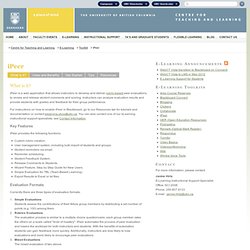
Click to enter. 2 panels are displayed showing the evaluations needed to be completed and submitted evaluations. To complete an evaluation, click on its title on or before the due date. To view answers to an evaluation, click on its title. A new window or tab will pop up with the evaluations answers and results. For Instructors How and Why of Peer EvaluationEliminates or reduces inflated assessments Less stressful environment (proximity of persons being assessed) Quick results Saves class time for other things. If you are using the same groups for the entire term, it will be helpful to do a peer assessment 3 times. Considerations to use iPeer: Do students have access to the results in order to plan for improvement? The assessments of group process should be formative (more than once) so that there is motivation to contribute and improve. Steps in Developing a Rubric: Laisser 20% du temps aux élèves pour des projets.
I love learning and am a big advocate of creativity.

So when I read about Google's concept of '20% Time' I knew I had to find a way of sneaking it into the ethos of my classroom. In short, Google offers its engineers 20% of their timetable to work on their own projects – things that they are truly passionate about and not things necessarily in their job description. Fairly radical. And I couldn't help thinking, if it works for Google, could it work for education? Some teachers out there are using it (some don't give it a title) and therefore I planned to launch 20% time in my classroom at the start of the fifth term and, naturally, I wanted to make a big thing of it to the children.
. • It must be some type of learning and you must document it in your Homework Diary• This work, and all other work, must be of the highest standard• It may be continued at home• You have access to most resources as long as the use can be justified• You may work in groups of up to four people. Pédagogie de projet et ses composantes. Le travail d'équipe efficace. Pédagogie en ilots. Ilots et tablettes en anglais. Enseigner avec les ilots. Ilots, groupes et cocotiers ou le pédagogique sous les tropiques. Je n’y croyais pas.
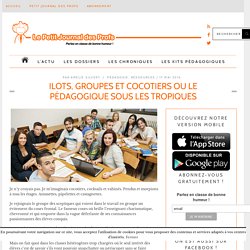
Je m’imaginais cocotiers, cocktails et vahinés. Pendus et morpions à tous les étages. Amusettes, pipelettes et castagnettes. Je rejoignais le groupe des sceptiques qui voient dans le travail en groupe un évitement du cours frontal. Le fameux cours où brille l’enseignant charismatique, chevronné et qui emporte dans la vague déferlante de ses connaissances passionnantes des élèves conquis. Ceux qu’on se représente dans l’univers cathodique et filmique, Sam prof version trash, Sophie Marceau à la Sorbonne, version chic. Mais on fait quoi dans les classes hétérogènes trop chargées où le seul intérêt des élèves c’est de savoir s’ils vont pouvoir snapchatter ou périscoper sans se faire choper allongés sur leurs tables, le bras ou carrément la tête dans le sac à main/cartable qui leur sert d’abri téléphonique ?
Hé ben, on met les élèves en groupes. Comment placer les tables ? Petit truc. Les îlots ludifiés version allégée ou jouer cartes sur table. AP – Travail de groupe. Travail en ilots bonifiés. Travailler en îlots bonifiés. Nous profitons de la sortie du livre de Marie Rivoire sur le travail en îlots pour lancer une discussion sur les conditions d’un travail de groupes réussi.
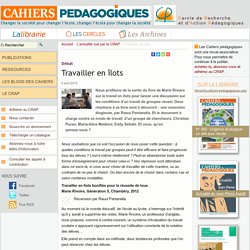
Deux réactions à ce livre sont à découvrir : une recension élogieuse, par Raoul Pantanella. Et le document à charge contre ce mode de travail, d’un groupe de chercheurs, Christian Puren, Maria-Alice Médioni, Eddy Sebahi. Et vous, qu’en pensez-vous ? Nous souhaitons que ce soit l’occasion de nous poser cette question : à quelles conditions le travail par groupes peut-il être efficace et faire progresser tous les élèves ?
L’est-il même réellement ? Travailler en îlots bonifiés pour la réussite de tous Marie Rivoire, Génération 5, Chambéry, 2012 Recension par Raoul Pantanella Elle prend en compte dans sa méthode, deux tendances profondes que l’on peut observer chez les élèves. Ilots bonifies - fausse bonne idée ? Travailler en ilots bonifies. Un an avec Classcraft – Essai de bilan – Hypothèses d'École. Bilan provisoire d’une brève expérience. Gamification de la gestion de classe avec Classcraft. Îlots ludifiés. FlipMusicLab.fr – Activités dans les cours d éducation musicale en classe inversée.
Evaluer les îlots ludifiés – FlipMusicLab.fr.